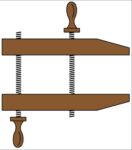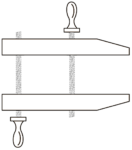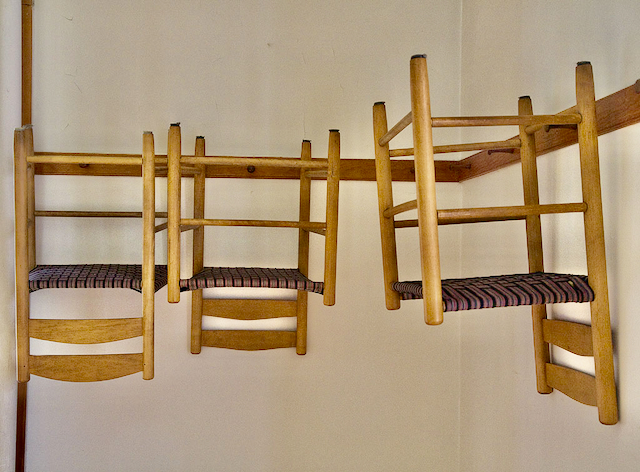Shaker history in America is closely tied to woodworking because furniture making was a fundamental element of their movement. Notable San Diego woodworker, Pat Edwards, studied Shaker furniture some years ago and developed a close, personal relationship with Shaker communities. You will find his blog on his experience at: http://wpatrickedwards.blogspot.com/search?q=shakers
Ann Lee, founder of the movement was born in Manchester England in 1736. At the age of 22 she joined the Wardley Society, a religious sect known as Shaking Quakers or “Shakers” because of their style of worship. When Lee became the Wardley Society's leader it was experiencing severe persecution by the English authorities. Lee was jailed for a time. While in prison she the formed beliefs that eventually became the principles of Shakerism. She married a blacksmith, Abraham Standerin, in 1762 and gave birth to four children, all of whom died in infancy. In 1774, she sailed to America on the ship Mariah with her husband, brother and six other followers landing at New York. They lived there for two years until they purchased 200 acres in a place called Watervleit near Albany, New York and created a communal farming settlement later named New Lebanon.
A nearby Baptist group, led by Joseph Meacham met the Shakers in 1780 and joined their community. For two years members conducted missionary work in New York and New England, attracting many new followers. But their religious beliefs, odd style of worship, and suspicion of being spies for the British led to persecution, beatings, arrest and other abuse. Mother Ann Lee died in 1784. James Whittaker, one of her original followers, became the next inspiring leader. He was succeeded by Joseph Meacham who defined Shaker church laws; separation from society, common ownership, pacifism, equality of sexes and celibacy; codified as “The Millennial Laws”. Meacham appointed Lucy Wright to be the Shaker's female leader. She led the group for 20 years after Meacham died.
The Shaker movement grew rapidly. After 1850 it reached a peak of 6,000 members located in 19 settlements from New York to Florida, Kentucky and Indiana. The New Lebanon settlement was renamed Mount Lebanon in 1861 and became the permanent seat of the movement. Nearly all new members joined as adults, some with their own children and orphans. Although men and women lived in dwellings under the same roof they were strictly segregated, did not marry and practiced celibacy.
Shakers were highly productive and ingenious; adopted the metric system, were successful farmers, created cottage industries, first to package and market garden seeds, largest producers of medicinal herbs in America. Shaker inventions include the flat broom, metal pen nibs, a screw propeller, pea sheller, threshing machine, apple parer, turbine water wheel, the common clothes pin, condensed milk, an industrial washing machine, waterproof fabric, a ball and socket tilting chair glide, a metal chimney cap. Last but not least, Shaker Tabitha Babbitt invented a circular saw blade driven by a water mill in 1813. She also devised the method for making wrought iron nails by shearing cut nails from a metal sheet. Shakers believed that patents were incompatible with the Christian spirit and never patented the circular blade. A Frenchman did so three years later. Shakers later relaxed their view of patents. By 1877 they had patented 33 of their inventions.
Robert Wagan came to live with the Shakers at Mount Lebanon in 1839. He joined the South Family who had started large scale chair making and selling to the public around 1850. Their chairs originally sold for $0.50 each. If you could find a genuine example today it would be worth thousands. In about 1870 Wagan took over Shaker chair making, introduced standardized parts and mass production techniques, rebuilt the factory, set up a show room for display and issued catalogs under the name R. M. Wagan & Co.
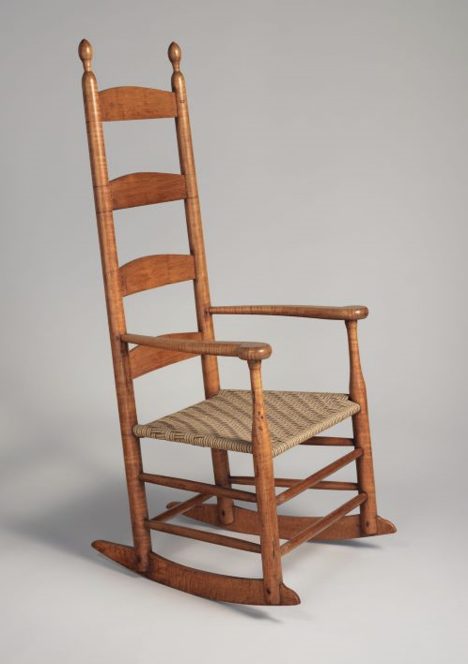
The Shaker ladder (or slat) back chair became a major source of income for the society. It was shipped world wide in different sizes and models. The chair's popularity led commercial furniture companies to begin selling copies which forced Wagan to obtain a trademark. In 1879 he was made first elder of the South Family and led the community until his death in 1883.
An intense spiritual revival in the movement developed in this period; with increasingly strict rules of behavior and intense religious practice. The number of new converts declined. Settlements began to close. The civil war, industrial revolution, tension between traditional leaders and young members, the appeal of urbanization and the fact that Shakers did not marry or produce children all contributed to more losses. By 1900 only a thousand members were left. In 1922 seven communities in the northeast were still active. In 1998 seven Shakers lived in the Sabathday Lake, Maine Shaker community; originally founded in 1783. Only two Shakers survive as of 2019.
The classic Shaker furniture style evolved from simple New England designs. In the years, before 1820, nearly all of the production was for personal or communal use. Furniture was plain and heavier than later work. The classic period, from 1820 to 1860, is characterized by subtle tapers, cautious chamfers and bevels and more varied pulls and finials, always wood. A brief period of Victorian design influence developed after the civil war but did not last. Shaker artisans believed that worship of God was expressed in the integrity of one's work; as Becksvoort writes, “Shaker furniture is an expression of their religious vision”.
Eastern settlements used white pine, maple, cherry, birch and walnut. Western settlements used those and more walnut; ash and soft maple when they could find it. Joinery was always straightforward but very precise; with dovetails, mortise and tenon joints, frame and panel doors, usually raised. Moldings were not used at all or very simple. Legs could be square or circular in cross section, usually tapered, occasionally bottle shaped. S-shaped (cyma) curves were often used on stands and desks. Early finishes were either varnish or paint; later, transparent washes of paint as a stain. Upholstery was not used except for padding in woven chair seats.
Shaker designs are characterized by utilitarian principles; form should follow function; no ornamentation. Most case pieces used the golden ratio, (phi 1:1.618) and, most important, simplicity and utility. Distinctive features include built-in drawers and cupboards placed along walls, in corners, or stairwells and extensive use of wall mounted peg rails for storing chairs and other objects. Shaker style even had an important influence on Scandinavian design.
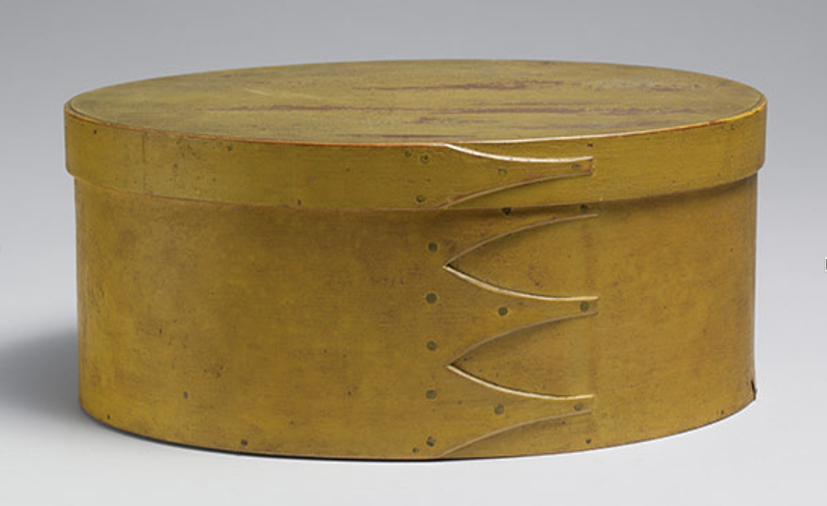
The oval box, first made around 1798, is a signature Shaker design; distinguished by swallowtail fingers (lappers) held by copper tacks clinched on the inside; a useful, ingenious and charming object you must see to appreciate. At first they were only made for personal use. Thousands were also sold, becoming a profitable product. If you would like to make an oval box there is a fine source for supplies and advice: John Wilson's The Home Shop at: http://www.shakerovalbox.com/
FWW, December, 2019 has a nice article about making a Shaker berry box with a handle.
You will never see a genuine Shaker canopy bed, coffee or tea table, entertainment center or spindle back chair; all too fussy. In fact, today you may not find any genuine Shaker-made piece outside of a museum or private collection. Except for the chairs and oval boxes, few pieces were ever sold. When communities dissolved most of the furniture was simply auctioned off or given away and neglected.
An excellent collection of images of authentic Shaker furniture with informative accompanying text can be found on the website of the Metropolitan Museum at:
https://www.metmuseum.org/toah/hd/shak/hd_shak.htm
Two fine books on the subject are; Christian Becksvoort's annotated, beautifully illustrated The Shaker Legacy, and John Kassay's The Book of Shaker Furniture, containing 66 detailed construction drawings with dimensions plus 264 photos of authentic Shaker furniture.
By Dick Ugoretz (originally published on November 2019)
Editor's Note: Light edits have been made to remove broken web links.
